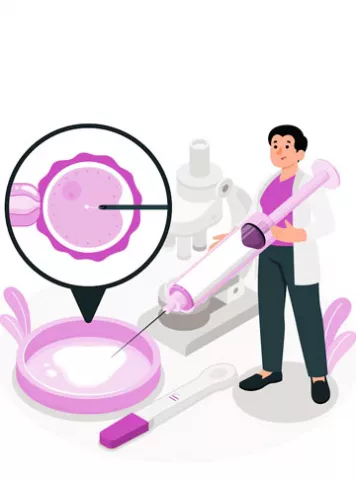What is Necrozoospermia?
Necrozoospermia, also known as necrospermia, is a condition where a significant portion of sperm in a semen sample is immobile or dead. Essentially, these sperm are incapable of fertilizing an egg due to their lack of motility or viability. While a certain percentage of non-motile sperm is normal in any semen sample, excessive amounts can hinder fertility.
Who can get Necrozoospermia?
Necrozoospermia can affect men of reproductive age, particularly those who are attempting to conceive with their partners. It is essential to understand the potential factors that contribute to this condition and how it can impact fertility.
What are the Types of Necrozoospermia?
Necrozoospermia can be categorized into two main types:
1.Complete Necrozoospermia: In this type, all sperm present in the semen sample are non-motile and non-viable.
2.Partial Necrozoospermia: This type involves a significant proportion of non-motile and non-viable sperm, but some healthy and motile sperm are also present.
Understanding the type of Necrozoospermia is vital in determining appropriate treatment and management strategies.
What are the Causes of Necrozoospermia?
Several factors can contribute to the development of Necrozoospermia, including:
- Genetic Factors: Genetic abnormalities can lead to non-viable or immotile sperm.
- Testicular Disorders: Conditions affecting the testicles, such as infections, injuries, or radiation exposure, can impact sperm production and quality.
- Varicocele: Varicocele is the enlargement of veins in the scrotum, which can cause overheating and adversely affect sperm production.
- Exposure to Toxins: Exposure to certain toxins, such as chemotherapy drugs, radiation, or excessive heat, can harm sperm quality.
- Infections: Infections of the reproductive tract can lead to Necrozoospermia.
- Autoimmune Disorders: Conditions where the immune system attacks sperm cells, affecting their viability and motility.
What are the Symptoms of Necrozoospermia?
Necrozoospermia typically does not present with specific noticeable symptoms. The primary indication is the presence of non-motile and non-viable sperm in a semen analysis. Couples facing difficulties in conceiving might undergo fertility testing, where Necrozoospermia can be diagnosed.
Does Necrozoospermia affect Fertility?
Necrozoospermia can impact fertility significantly. Non-motile and non-viable sperm are unable to fertilize an egg, reducing the chances of successful conception. If Necrozoospermia is present, assisted reproductive techniques, such as In Vitro Fertilization (IVF) or Intracytoplasmic Sperm Injection (ICSI), may be recommended to achieve pregnancy.
How is Necrozoospermia Diagnosed?
Necrozoospermia is diagnosed through a semen analysis, also known as a sperm count test. During this test, a sample of semen is collected and examined under a microscope to assess the concentration, motility, and morphology of sperm. If a significant portion of the sperm is found to be immotile or non-viable, Necrozoospermia is diagnosed.
How is Necrozoospermia Treated?
The treatment of Necrozoospermia depends on its cause and type. Treatment options may include:
- Lifestyle Changes: Adopting a healthy lifestyle, including a balanced diet, regular exercise, and avoiding toxins, can improve sperm quality.
- Surgery: Surgical procedures can be done to correct conditions like varicocele or remove obstructions in the reproductive tract.
- Hormonal Therapy: Hormonal treatments can be used to address hormonal imbalances affecting sperm production.
- Assisted Reproductive Techniques (ART): ART methods such as IVF or ICSI can bypass the issues caused by Necrozoospermia by directly injecting viable sperm into an egg for fertilization.
Conclusion
Necrozoospermia, characterized by a significant proportion of non-viable and non-motile sperm in the semen, is a condition that can hinder fertility. Understanding its types, causes, symptoms, and impact on fertility is essential for individuals and couples facing difficulties in conceiving. With advancements in assisted reproductive techniques, couples affected by Necrozoospermia have viable options to achieve their dream of parenthood.
Articles
2023


Male Infertility Guide to infertility treatments
अशुक्राणुता (एजुस्पर्मिया) के कारण, लक्षण और उपचार (Azoospermia in Hindi)
माता-पिता बनने से महरूम रहना भ...
2023


What is abnormalities in sperm?
Sperm is a crucial component of the reproductive system in males. It is a spec...
2023


Female Infertility Male Infertility
How many days Sperm Live in Female Body after Intercourse?
While it depends on the correct circumstances and the stage of the woman's men...
2023


Male Infertility Infertility Tips
Hyperspermia: Causes, Symptoms, Diagnosis & Treatment
What is Hyperspermia? Hyperspermia is a condition where an individual produ...
2022


पुरूष निःसंतानता का एक कारण वेरिकोसिल आधुनिक तकनीकों से संभव है पिता बनना
पुरूष निःसंतानता शब्द कुछ सा�...
2023


Male Infertility Guide to infertility treatments
What is Varicocele? Varicocele is a medical condition where the veins in th...
2022


Infertility Tips Male Infertility
Does Obesity Cause Infertility in Males
How Are Obesity And Male infertility Related? Male Infertility and Obesity ...
2022


Infertility Tips Male Infertility
Male Infertility Medicine: How does IVF help Male Infertility
What is Male Infertility? Male infertility is the lack of ability to genera...
2022


Infertility Tips Male Infertility
In addition to spermatozoa, semen is composed of prostatic and seminal vesicul...
Pregnancy Calculator Tools for Confident and Stress-Free Pregnancy Planning
Get quick understanding of your fertility cycle and accordingly make a schedule to track it















